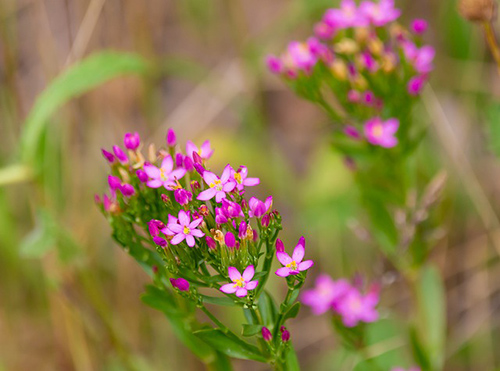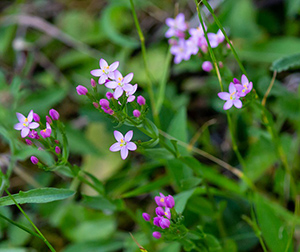Contents

The European centaury plant was used to heal the foot of Chiron the centaur, a mythical being, half man and half horse inflicted by the legendary Hercules. This plant is named after the centaurs. It is also called lesser centaury to distinguish it from the greater centaury (Centaurea scabiosa L.), which belongs to the Compositae family and is not used in phytotherapy.
European Centaury Plant Scientific Facts
- Other names: Drug centaurium, lesser centaury, centaury, common centaury, bitter herb.
- French: Petite centauree.
- Spanish: Centaura menor.
- Environment: The European centaury plant grows in pastures and prairies all over Europe, however not very frequently. It has been naturalized to some areas in the warm regions of America.
- Description: Herbaceous plant of the Gentianaceae family, which grows from 10 to 50cm high, with elongated leaves forming a rose in the base of the plant, and pink, terminal flowers.
- Part of the plant used medicinally: The flower heads.
- 🌿Pure and Natural: Common Centaury Herb Herba Organica is hand-picked from the wild and carefully packed, with no additives, preservatives, or artificial ingredients.
- 🌿Sustainable Sourcing: Ethically sourced using sustainable methods to protect the environment while delivering a reliable product.
- 🌿Reusable Packaging: The resealable doypack keeps herbs fresh and helps minimize environmental impact.
- 🌿GMO-Free: Completely GMO-free with no additives, offering a natural and pure option.
- 🌿Versatile Use: Enjoy on its own or mix with other herbal teas for a customized blend.
Healing Properties and Indications

The whole plant contains several bitter components of the glycosidic type. As its Latin name (fel terrae) suggests, it is very bitter in flavor, though less than the gentian, and many of its properties are similar to the latter. This plant is an excellent remedy for the following conditions:
- Stomach ailments: Like all plants containing bitter components, the European centaury plant invigorates digestive processes and increases appetite. It also increases gastric juice production and stimulates the stomach’s ability to empty. It is recommended for chronic gastritis caused by lack of gastric juice, lack of appetite, bloated stomach, intestinal fermentation, and vomiting. The plant also has choleretic properties and thus is used for chronic liver disorders.
- Hypoglycemic: By decreasing the blood sugar level, it is beneficial for people who have type 2 diabetes.
- Mild laxative and febrifuge.
- Cicatrizant: It cleans and heals skin wounds, sores, ulcers, and eczema.
How to use European Centaury
- Infusion with 30g of flower heads per liter of water. Drink a cup before each meal, preferably without sugar. When used as an antidiabetic medicine, it can be sweetened with chemical sweeteners like saccharin, although we advise against taking too much.
- Compresses soaked in a decoction of 50g of flower heads per liter of water, then applied on the affected area.

Rough Centaury
The rough centaury (Centaurea aspera L.), which is also quite bitter, has even more intense hypoglycemic properties than the European centaury. The former can substitute for orally taken antidiabetic medicines and allows patients to reduce insulin doses. Blood tests must be carried out (glucose) during the first days of treatment to regulate the adequate dosage for this plant since its use can even produce hypoglycemia (excessive decrease of the glucose level).
Therefore, medical supervision is required to use this plant. The usual dose is 1-3 infusion cups daily, after meals. The infusion is prepared with 30g of flower heads per liter of water, preferably not sweetened.
DISCLAIMER: All content on this website is presented solely for educational and informational objectives. It would be best to not rely on the information provided as a replacement for advice, diagnosis, or treatment from a qualified medical expert. If you are pregnant, nursing, or have any preexisting medical concerns, you should talk to your doctor before using any herbal or natural medicines.
REFERENCES
- George D. Pamplona-Roger, M.D. “Encyclopedia of Medicinal Plants.” George D. Pamplona-Roger, M.D. Encyclopedia of Medicinal Plants. Ed. Francesc X. Gelabert. vols. 2 San Fernando de Henares: Editorial Safeliz, 2000. 436,437. Print. [European centaury plant]
- Länger, R., & Kubelka, W. (2002). Secoiridoids from Centaurium erythraea and Centaurium littorale. Phytochemistry, 59(3), 353–356.
- Yarnell, E., & Abascal, K. (2002). Botanicals as digestives. Alternative & Complementary Therapies, 8(4), 205–212.
- Speranza, L., Franceschelli, S., Pesce, M., Menghini, L., Patruno, A., Vinciguerra, I., De Lutiis, M. A., Felaco, M., & Grilli, A. (2009). Anti-inflammatory properties of the plant Centaurium erythraea Rafn (Gentianaceae). Journal of Ethnopharmacology, 122(2), 258–263.
Last update on 2025-06-15 / Affiliate links / Images from Amazon Product Advertising API






